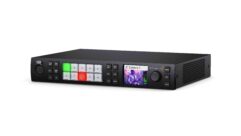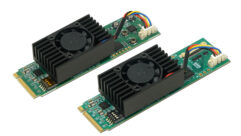
Community M-Class M12
May 1, 2005 12:00 PM,
By John McJunkin
Compact stage monitor shines with vocals.
In the age of in-ear monitors when artists, speakers, and clergy have new, previously nonexistent options, manufacturers of floor-wedge monitors are working harder than ever to make their products as low profile as possible. Those who take the stage usually wish to present a visual that is not obstructed with gigantic speakers. It’s abundantly clear that Community has strongly considered this issue when developing its M-Class M12 stage monitor, but that’s not the only factor the company considered. It clearly put a significant amount of forethought in the development of this floor wedge. Let’s examine it in detail to see what Community did.
First, the monitor’s impressive physical attributes. It’s 21.5in. wide, 20.75in. deep, and an impressively low-profile 10.5in. tall. It covers little precious space on stage, and it does not protrude like Mount Everest. The M12 is formed of a multi-layer glass composite and feels very sturdy. Weighing in at 56lbs., it has a very solid feel. Its curved stainless steel grille also looks and feels very substantial — “Texas Boot-proof” as Community touts it. The entire construct (except the grille) is coated in an abrasion-resistant, non-reflective Tuf-Coat finish, available in flat black or white. A clever rotating cable-locking mechanism enables the user to connect the cables and have them emanate from the back or either side of the monitor. The NL4 connectors are situated such that they are literally unreachable when the monitor is in position, virtually eliminating any possibility of their being kicked or otherwise disturbed. A nicely rubberized handle is concealed in the same hollow as the connectors, as is the healthy bat-handle switch that toggles between passive and bi-amp operation. Actually, there are two different versions available: one that is intended strictly for bi-amp operation and the one I test drove, which is switchable between bi-amp and passive operation. Overall, this cabinet has a very clever, unobtrusive design, and although it’s not quite invisible, it does have an appealing, artsy appearance.
The M12 is a two-way system. The LF driver is a 12in. unit with impedance of 8Ω and sensitivity of 99dB SPL at 1W/1M (100Hz to 1600Hz.) The recommended crossover frequency in bi-amp mode is indeed 1600Hz. Frequency range extends down to 55Hz, but is 3dB down at 80Hz. The HF component is a 2in. exit B&C wide band driver. It’s mounted to a molded one-piece asymmetrical horn with a pattern that narrows from 90 degrees at the top to 40 degrees at the bottom. The frequency range of the HF driver extends up to 18kHz, but is 3dB down at 15kHz. Nominal impedance for the HF component is also 8Ω, and sensitivity is rated at 106dB SPL at 1W/1M (1600Hz to 16kHz.) Maximum system input in passive mode is 300W continuous, 750W program (49V RMS, 110V momentary peak), and the recommended power amp in passive mode will provide between 630W and 900W at 8Ω. Community recommends the same amplifier attributes for the LF driver in bi-amp configuration, and an amp providing 130W to 190W at 8Ω for the HF driver. The HF driver is rated for 80W continuous, 160W program (25V RMS, 51V momentary peak.) Nominal impedance for the entire system in passive mode is 8Ω, and the overall maximum output is 124dB SPL with peaks of up to 131dB SPL. Minimum system impedance is 7.6Ω (at 240Hz). As stated before, connection is made with standard NL4 connectors.
Community recommends the M12 for live sound reinforcement, houses of worship, and TV and stage production. Bearing this in mind, I test drove this monitor with a QSC PLX2402 amplifier and listened to a very wide range of program material, from full music mixes to individual instruments and vocals. Overall, the performance is quite solid. In particular, the HF driver is impressive, yielding bright clarity in the intelligibility range of frequencies. As a matter of fact, a person might even perceive a bit of a bump in that part of the spectrum, something undesirable in a studio monitor, which should ostensibly be flat across the spectrum. This speaker, however, is intended to provide maximum clarity vis-à-vis on-stage monitoring, where vocal clarity is highly desirable, and this monitor definitely delivers the goods in that application. And while the M12 is not intended to be a super high-fidelity near-field studio monitor, the top end of the spectrum is also appropriately presented with a high degree of clarity. There is definitely some nice air up top.
Listening to broadband full mixes, I discovered that the entire spectrum is well represented with the notable exception of deep bass. This is the virtually insurmountable trade-off associated with compact stage monitors. In order to represent lower frequencies, larger cabinets and larger LF components are necessary, and in order to keep the speaker to a manageable and unobtrusive size, a compromise is necessary. Community has handled it nicely here, with a 12in. component that reaches down to the 80HZ to 100Hz range and slopes gently down in SPL from there. Don’t expect it to thump or rumble, but bass notes are clearly heard. In critical applications where extended low-end is needed, some fortification may be necessary, but remember that this is a monitor intended for use at the front of the stage in applications where a small footprint and low profile are desired. I’m not aware of any such low-profile wedge monitor that provides copious sub-bass.
Listening to isolated instruments, I realized that Community really did its homework with this monitor. While broadband mixes sound great in this monitor, it really shines when it does what such monitors are intended to do: provide a sparing mix of a handful of instruments for the benefit of musicians on stage. Bass and drums sounded tight and clear from the M12, as did other rhythmic instruments like piano and guitars. Wind instruments sounded particularly nice, but the real strength of this monitor is for vocals. I listened to an array of both male and female vocals, including small vocal ensembles from both genders. It’s clear the Community put in some serious effort to ensure that vocals of all kinds would be presented clearly and intelligibly. Even spoken word program content was very clearly presented with full human voice range represented. One other important factor is that I had to really drive the speaker to hear any significant distortion, and if anything, my amp was a little underpowered for this application. M12 users are not going to suffer any substantial distortion unless they’re getting into ridiculously high SPLs.
The Community M12 should be on your short list if you’re looking into compact floor-wedge monitors. It provides a taut, clear signal, and it cuts a pleasingly low profile. And as I said before, although it’s not quite invisible, its artfully done shape makes it aesthetically pleasing. This is a truly impressive monitor.
SPECIFICATIONS
Loudspeaker Type two-way, full-range, bass ported
Operating Range 55Hz to 18kHz, 80Hz to 15kHz (±3dB)
Max Input (passive) 300W continuous, 750W program, 49V RMS, 110V momentary peak
Max Inputs (bi-amp)
LF (same as for passive mode)
HF 80W continuous, 160W program, 25V RMS, 51V momentary peak
Sensitivity 1W/1m
LF 99dB SPL (100Hz to 1600Hz, 1/3-octave bands)
HF 106dB SPL (1600Hz to 16kHz, 1/3-octave bands)
Maximum Output 124dB SPL/131dB SPL (peak)
Nominal Impedance (passive) 8Ω
Min Impedance 7.6Ω @ 240Hz
Nominal Impedances (bi-amp)
LF 8Ω
HF 8Ω
Dimensions height 10.5in (266.7mm), widest point: 21.5in. (546.1mm), depth: 20.75in. (527.1mm)
Weight: 56lbs. (25.4 kg)
PRODUCT SUMMARY
Company: Community Professional Loudspeakers
www.loudspeakers.net
Product: M12 stage monitor
Pros: Clear, low-distortion operation and high intelligibility for vocals
Cons: Fortification necessary for sub-bass
Applications: Live sound, houses of worship, and TV and stage production
Price: $2,330
John McJunkinis the principal of Avalon Studio Services in Phoenix and consults for both studios and live sound applications.










